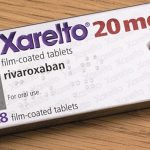Why Does Xarelto Cause Leg Pain?

What is Xarelto?
Xarelto is a brand of rivaroxaban an anticoagulant prescribed to treat and prevent dangerous blood clots in your body. Rivaroxaban is in a class of medications called factor Xa inhibitors. It works by blocking the action of a certain natural substance that helps blood clots to form.
Specifically, Xarelto is FDA approved for use in adults to:
• Treat deep vein thrombosis (DVT). A DVT is a blood clot that forms in a vein deep inside your body. DVTs usually form in a vein in your leg, but they can also form in your arm.
• Treat pulmonary embolism (PE). A PE is a blood clot that blocks blood flow to your lungs. PEs develop when a DVT gets dislodged from a vein and travels through your bloodstream toward your lungs.
• Reduce the risk of getting another DVT or PE. Xarelto can be used for this purpose if you’re still at risk of having blood clots after at least 6 months of treatment for a past DVT or PE.
• Prevent DVT and PE following hip or knee replacement surgery. Xarelto is used for this purpose because these types of surgeries increase your risk of developing blood clots.
• Prevent blood clots in people admitted to a hospital with an acute medical illness who are at risk of blood clots. Xarelto is used for this purpose because you have a higher risk of blood clots if you’re on bed rest or you can’t move around much. For this use, your doctor may prescribe Xarelto during your hospital stay and for a period of time after you’re discharged from the hospital.
• Prevent blood clots and stroke in people with atrial fibrillation (A-fib) that’s not caused by a heart valve problem. A-fib is a type of irregular heartbeat that can disrupt blood flow around your body. This condition increases your risk of having blood clots that can travel to other parts of your body, such as your brain. (Blood clots that travel to your brain can lead to stroke.)
• Prevent blood clots that can cause heart attack, stroke, or death in people with coronary artery disease (CAD). With CAD, you have narrowed arteries in your heart. This condition increases your risk of developing blood clots in your arteries, which can lead to heart attack, stroke, or death. For this purpose, Xarelto is prescribed for use with low-dose aspirin to help prevent blood clots.
• Prevent certain complications from blood clots in people with peripheral artery disease (PAD). With PAD, you have narrowed arteries in your legs. This condition increases your risk of developing blood clots in your arteries. These clots can lead to heart attack, stroke, lack of blood flow in limbs, and the possible need for amputation (removal of a limb). For this purpose, Xarelto is prescribed for use with low-dose aspirin to help prevent blood clots.
How should Xarelto be used?
Rivaroxaban comes as a tablet to take by mouth. When rivaroxaban is used to treat DVT or PE, it is usually taken with food twice daily for 21 days, then once daily with food. When rivaroxaban is used to prevent DVT or PE, it is usually taken once daily with or without food after at least 6 months of anticoagulation (blood thinner) treatment. When rivaroxaban is used to prevent a stroke in those who have atrial fibrillation, it is usually taken once daily with the evening meal. When rivaroxaban is taken to prevent DVT and PE after hip or knee replacement surgery, it is usually taken with or without food once daily. The first dose should be taken at least 6 to 10 hours after surgery. Rivaroxaban is usually taken for 35 days after hip replacement surgery and for 12 days after knee replacement surgery. When rivaroxaban is taken to prevent DVT and PE in people who are hospitalized for serious illnesses and are at risk of developing a clot due to decreased ability to move around, it is usually taken with or without food once daily starting when you are in the hospital and then continuing for a total of 31 to 39 days. When rivaroxaban is taken along with aspirin in people with coronary artery disease or peripheral arterial disease, it is usually taken twice daily with or without food. Take rivaroxaban at around the same time every day. Follow the directions on your prescription label carefully, and ask your doctor or pharmacist to explain any part you do not understand. Take rivaroxaban exactly as directed. Do not take more or less of it or take it more often than prescribed by your doctor.
If you are unable to swallow the tablets, you can crush them and mix with applesauce. Swallow the mixture right after you prepare it. Rivaroxaban can also be given in certain types of feeding tubes. Ask your doctor if you should take this medication in your feeding tube. Follow your doctor’s directions carefully.
Continue to take rivaroxaban even if you feel well. Do not stop taking rivaroxaban without talking to your doctor. If you stop taking rivaroxaban, your risk of a blood clot may increase.
Why Does Xarelto Cause Leg Pain?
Xarelto works by blocking the action of a certain natural substance that helps blood clots to form, it competitively inhibits Factor Xa, demonstrating more than 10,000-fold selectivity for Factor Xa than other related serine proteases. However, in some people, this can cause numbness, tingling, and muscle weakness are particularly likely to affect your feet and legs.
While leg pain is not a common side effect of Xarelto, some people taking the medication may experience this symptom. There are several potential reasons why Xarelto could cause leg pain:
1. Bleeding: One of the most common side effects of Xarelto is bleeding, which can cause pain and discomfort in the affected area. If Xarelto causes bleeding in the leg, this could lead to leg pain.
2. Blood vessel damage: Xarelto can cause damage to blood vessels, which can lead to inflammation and pain in the affected area. This could occur in the leg if Xarelto causes damage to the blood vessels in the leg.
3. Nerve damage: Xarelto can cause nerve damage, which can lead to pain, numbness, or tingling in the affected area. This could occur in the leg if Xarelto causes nerve damage in the leg.
4. Deep vein thrombosis: While Xarelto is used to prevent DVT, in rare cases, it can also cause this condition. DVT is a blood clot that forms in the deep veins of the leg and can cause pain, swelling, and redness in the affected leg.
5. Muscle pain: Xarelto can cause muscle pain or myalgia in some people. This could occur in the leg if Xarelto causes muscle pain in the leg.
If the Xarelto-induced leg pain is severe, call the doctor who prescribed the medicine before taking another dose. The medicine may need to be stopped, changed, or the dose adjusted. An appointment may not be necessary. If you are taking any medicine not prescribed by a doctor, stop taking the medicine. Talk to your doctor if you think you need to continue taking the medicine.
Xarelto side effects
Get emergency medical help if you have signs of an allergic reaction to Xarelto: hives; difficult breathing; swelling of your face, lips, tongue, or throat.
Also seek emergency medical attention if you have symptoms of a spinal blood clot: back pain, numbness or muscle weakness in your lower body, or loss of bladder or bowel control.
Xarelto can cause you to bleed more easily. Call your doctor at once if you have signs of bleeding such as:
• easy bruising or bleeding (nosebleeds, bleeding gums, heavy menstrual bleeding);
• pain, swelling, new drainage, or excessive bleeding from a wound or where a needle was injected in your skin;
• any bleeding that will not stop;
• headaches, dizziness, weakness, feeling like you might pass out;
• urine that looks red, pink, or brown; or
• bloody or tarry stools, coughing up blood, or vomit that looks like coffee grounds.
Bleeding is the most common side effect of Xarelto.
Common Xarelto side effects may include:
• muscle pain;
• itching; or
• pain in your arms or legs.
This is not a complete list of side effects and others may occur. Call your doctor for medical advice about side effects. You may report side effects to FDA at 1-800-FDA-1088.
What other drugs will affect Xarelto?
Tell your doctor about all medicines you use, and those you start or stop using during your treatment with Xarelto, especially:
• NSAID medications including aspirin, ibuprofen, acetaminophen, naproxen, celecoxib, diclofenac, indomethacin, meloxicam, and others and others).
• blood thinners including warfarin (Coumadin, Jantoven) and others;
• erythromycin;
• rifampin;
• antifungal medication – itraconazole or ketoconazole;
• HIV medication – indinavir, lopinavir, ritonavir; or
• seizure medication – carbamazepine, phenobarbital, phenytoin.
This list is not complete. Other drugs may interact with Xarelto, including prescription and over-the-counter medicines, vitamins, and herbal products. Not all possible interactions are listed in this medication guide.
How to cope with Xarelto side effects
What to do about:
• signs of anemia – talk to your doctor, who may arrange a blood test.
• feeling dizzy or lightheaded – if Xarelto makes you feel dizzy when you stand up, try getting up very slowly or stay sitting down until you feel better. If you begin to feel dizzy, lie down so you do not faint, then sit until you feel better. If the dizziness does not go away or keeps happening, speak to your doctor. They may arrange a blood test to see if you have anemia.
• a mild rash – it may help to take an antihistamine, which you can buy from a pharmacy. Check with the pharmacist to see what type is suitable for you. If the rash does not go away within a few days, speak to your doctor.
• feeling or being sick (nausea or vomiting) – stick to simple meals and do not eat rich or spicy food. If you’re vomiting, try having small, frequent sips of water to avoid dehydration.





